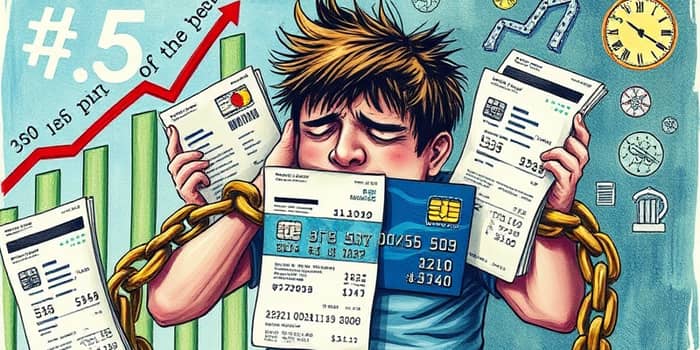
In today’s credit-driven economy, paying only the minimum amount due on credit card balances has become alarmingly common. What seems like a convenient option can quickly spiral into a long-term debt trap filled with hidden costs. By understanding the forces behind this trend, you can protect yourself from years of financial strain.
The latest data reveal record highs in minimum payment behavior. In Q4 2024, a staggering 11.1% of active US credit card accounts made only the minimum payments, the highest level in over a decade. Although Q1 2025 saw a slight dip, the share remains historically elevated after successive increases through 2024.
Credit card delinquency has also surged. Households in the lowest-income ZIP codes experienced a 63% rise in 30+ day delinquencies between 2021 and Q1 2025, compared to a 44% increase in higher-income areas. Meanwhile, the share of accounts 90 days past due is at record levels, signaling growing consumer stress.
Credit card debt remains a staple of American finances. With over 800 million credit cards in circulation and the average consumer juggling 3.9 cards, the temptation to carry a balance can be overwhelming. In Q2 2025, the average APR for new card offers soared to 24.35%, the highest level since December, making high balances even more punitive.
Several factors drive the minimum payment phenomenon. First, economic pressures such as inflated living costs and stagnant wages force many to allocate budgets just to cover essentials. Cost-of-living pressures and inflation create scenarios where anything above the minimum is simply unaffordable for millions.
During the pandemic, lenders loosened underwriting standards, expanding credit to at-risk borrowers. As emergency stimulus faded and inflation climbed, many found themselves carrying larger balances than ever. post-pandemic credit expansion environment intensified the challenge for those already struggling.
Behavioral trends also play a role. Known as the “minimum payment effect,” consumers anchor on the smallest required figure, underestimating the time and interest needed to clear balances. Combined with limited financial education, many cardholders never realize how much extra they pay over time.
Paying only the minimum can extend repayment from months to decades. With the average APR for balances accruing interest at 22.25% in Q2 2025, even small balances can grow exponentially through compounding.
Consider a $1,000 balance with a 22% APR, where the minimum payment is set at 2% of the balance or $20. At that rate, it could take over 26 years to pay off, with total interest exceeding $3,000. In contrast, a fixed monthly payment of $50 clears the balance in just three years, costing around $1,150 in interest.
An illustrative example of a typical household amplifies the danger. The Smith family, with a combined income of $45,000, shifted to minimum payments when childcare costs surged. Within two years, their balance doubled from $2,000 to $4,000 despite timely payments, demonstrating how compounding can work against disciplined payers.
Rising minimum payments and delinquencies highlight broader economic fragility. Banks rely heavily on interest income from revolving balances, designing payment structures that maximize long-term revenue. This industry reliance on minimum payments for profit can exacerbate consumer vulnerability.
As the Federal Reserve Bank of Philadelphia notes, this trend undermines credit health and can cascade into higher borrowing costs for all consumers. Behavioral economists warn that without targeted interventions, minimum-payment practices perpetuate inequality by hitting the most vulnerable hardest.
Moreover, elevated delinquency rates increase risk for charge-offs, which peaked in Q1 2025. These trends, concentrated among younger, lower-income, and subprime borrowers, may foreshadow wider economic downturns if left unaddressed.
Breaking free begins with a plan. Adopting targeted strategies can significantly reduce interest costs and payoff timelines.
Modern budgeting apps and credit management platforms leverage real-time analytics to show the cost differences between minimum and higher payments, helping users visualize the impact. Some apps even gamify progress, awarding badges for consistent overpayments.
Advocates call for reforms to protect consumers. Proposals include raising minimum payment thresholds, improving transparency around payoff schedules, and offering incentives for higher repayment levels. Enhanced disclosures could clarify the cumulative cost of carrying a balance, empowering cardholders to make informed decisions.
International examples offer models for reform: in some countries, regulators cap APRs and require clearer amortization charts on monthly statements. Adopting similar measures could mitigate the burden of high-interest debt in the US.
Financial education initiatives at schools and workplaces can also emphasize financial literacy and awareness of credit mechanics. Combined with policy updates, these efforts can reshape the industry toward more sustainable lending practices.
While minimum payments may offer short-term relief, they often mask a dangerous cycle of debt. By mastering payment strategies and understanding long-term implications, you can transform a perilous game into a path toward true financial freedom. Choose proactive repayment, seek knowledge, and reclaim control over your financial future before the minimum becomes a lifelong burden.
Empowering yourself starts with awareness and action. Seek out resources, consult financial advisors, and commit to paying more than the minimum each month. The path to financial resilience begins with a single extra dollar applied to principal.
References













